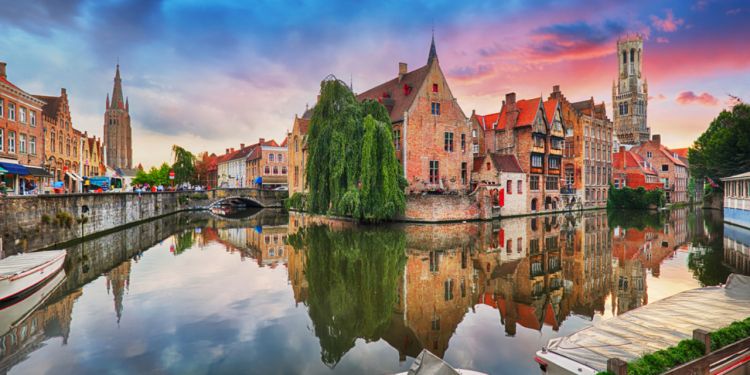Traveling to Belgium

Expatriation usually means having to deal with administration. Expat.com tells you which travel documents you need to cross Belgium's borders.
Every year, over 8 million people visit Bruges, a city in the Flemish region of Belgium. Many others travel to other parts of the country too, and some love it so much they decide to settle down in Belgium.
No matter which category you fall under, there are certain things you have to do to make sure your visit is completely legal. As in any country, Belgium requires its visitors to comply with local laws. Therefore, we advise you to do some research before your trip to avoid unpleasant surprises. We also advise that you have an up-to-date travel insurance policy.
Do I need a visa to enter Belgium?
You might think that you can just pack up and fly over to Belgium on a whim, especially if you have a particularly strong passport. But this is a common misconception that catches people out when they arrive in Belgium.
The fact is, there will probably be some paperwork involved, depending on where you're originally from. More specifically, it'll depend on whether you're a European Union (EU) or third-party national.
European Union nationals
As with every member state of the EU, citizens don't need a visa to cross Belgium's borders. Only identity papers or a valid passport are required. This rule applies to any person accompanying you if they stay no longer than 90 days.
If your stay exceeds 90 days, make sure you have enough resources. Your health insurance will have to cover all your medical care in Belgium. Furthermore, if you stay longer than 90 days, you'll have to register at the communal administration where you live in the three months following your arrival in Belgium.
If you wish to have a permanent residence in Belgium, you can ask for it after spending five uninterrupted years in the country. When you report your presence on Belgian soil at your arrival, you receive a registration certificate from the communal administration. The five-year time period starts upon receiving it.
Third-country nationals
If you aren't a citizen of one of the EU member states, then you need a visa to stay in Belgium, no matter how long you choose to stay. You can ask for it at the Belgian embassy or consulate in the country you live in.
Here are some reasons to enter Belgium and ask for a visa:
- Tourist visit
- Family or friends related visit
- Cultural or sport event
- Business trip
- Short internship
- Transit through the Schengen area
As for a long-term stay, you need authorization from the appropriate ministry.
Nationals from the following countries need a visa to enter Belgium:
Afghanistan, South Africa, Algeria, Angola, Saudi Arabia, Armenia, Azerbaijan, Bahrain, Bangladesh, Belize, Benin, Bhutan, Burma/Myanmar, Byelorussia, Bolivia, Botswana, Burkina Faso, Burundi, Cambodia, Cameroun, Cape Verde, China, Columbia, Comoro, Congo, North Korea, Ivory Coast, Cuba, Djibouti, Dominica, Egypt, Emirates, Ecuador, Eritrea, Ethiopia, Fiji, Gabon, Gambia, Georgia, Ghana, Grenada, Guinea, Guinea-Bissau, Equatorial Guinea, Guyana, Haiti, India, Indonesia, Iraq, Iran, Jamaica, Jordan, Kazakhstan, Kenya, Kirgizstan, Kiribati, Kosovo, Kuwait, Laos, Lesotho, Lebanon, Liberia, Libya, Madagascar, Malawi, Maldives, Mali, Morocco, Marshall (Islands), Mauritania, Micronesia, Mongolia, Mozambique, Namibia, Nauru, Nepal, Niger, Nigeria, Oman, Uganda, Uzbekistan, Pakistan, Palau, Papua New Guinea, Peru, Philippines, Qatar, Central African Republic, Democratic Republic of Congo, Dominican Republic, Russia, Rwanda, Saint Lucia, Saint Vincent and The Grenadines, Solomon (Islands), Samoa, Sao Tome, Et-Principe, Senegal, Sierra Leone, Somalia, Soudan, South Soudan, Sri Lanka, Surinam, Swaziland, Syria, Tajikistan, Tanzania, Taiwan, Chad, Thailand, East Timor, Togo, Tonga, Trinidad-and-Tobago, Tunisia, Turkmenistan, Turkey, Tuvalu, Ukraine, Vanuatu, Vietnam, Yemen, Zambia, Zimbabwe.
Exceptions for third-country nationals
Earlier, we said that if you aren't a citizen of an EU member state, then you need to get a visa to enter Belgium, regardless of the length of your stay. While is this true for the most part, there are actually some exceptions for third-country nationals.
More specifically, there are 61 exempt countries:
Albania, Andorra, Antigua and Barbuda, Argentina, Australia, Bahamas, Barbados, Bosnia and Herzegovina, Brazil, Brunei Darussalam, Canada, Chile, Colombia, Costa Rica, Dominica, El Salvador, Federated States of Micronesia, Georgia, Grenada, Guatemala, Honduras, Hong Kong, Israel, Japan, Kiribati, Macau, Macedonia, Malaysia, Marshall Islands, Mauritius, Mexico, Moldova, Montenegro, New Zealand, Nicaragua, Palau, Panama, Paraguay, Peru, Saint Kitts and Nevis, Saint Lucia, Saint Vincent and the Grenadines, Samoa, Serbia, Seychelles, Singapore, Solomon Islands, South Korea, Taiwan, Timor Leste, Tonga, Trinidad and Tobago, Tuvalu, Ukraine, United Arab Emirates, United States, Uruguay, Vanuatu, Venezuela.
This means that if you're from one of the above 61 countries, you won't have to apply for a visitor visa if you're staying in Belgium for under 90 days in a six-month period. And because the 26 countries in the Schengen Area have an agreement, you can move around in these countries unrestricted for 90 days in a six-month period as well. So it's always something to keep in mind if you want to visit other European countries!
Other conditions regulating access to Belgium and the Schengen area also apply. They vary according to your nationality, the type of visa, and the reason for your stay. You can find more information on that topic on the Schengen area website or on the article Visas for Belgium.
How to get to Belgium
Now that we've gotten the formalities out of the way, you might be wondering about how to get to Belgium after you've sorted your paperwork. Thankfully, there are several ways you can get to this country: driving, flying, or taking the train or ferry.
Driving to Belgium
If you're driving to Belgium, then you'll need to make sure you have the proper travel documents in order. In addition to your driver's license, you'll also need insurance and vehicle documents. If you don't own the vehicle you're driving, then you'll need to bring written proof of permission from the actual registered owner.
For those of you coming from the UK, do note that like in most continental European countries, you'll have to drive on the right side of the road. To get from the UK to Belgium, you can drive to the Eurotunnel Folkstone Terminal in London by taking the M20 and taking exit 11A. On the other side of the tunnel is Calais, France.
You can then drive on the E40, which will take you up the coast of Northern France and cross into Belgium. If you stay on this route, you'll end up in Bruges in about 1.5 hours. Otherwise, you can drive two hours to get to Antwerp.
Here are the routes to take coming from the other surrounding countries:
- Germany: take either the A44 or the A4 and A4.
- Luxembourg: take either the E411 and/or the E25
- Netherlands: take the A27 and E19 or the A2
Taking the Train to Belgium
What's great about Belgium is it's surrounded by a few countries, which means there will be trains to take from every direction.
For example, the Netherlands has convenient trains leaving from the Randstad area, which include the country's four largest cities (Amsterdam, Rotterdam, The Hague, and Utrecht). You have two options here: the Intercity Brussels or the Thalys.
The Intercity Brussels leaves 16 times a day and can get you from Amsterdam to Antwerp within 1.5 hours. This train passes through The Hague HS (there are four departures per day here), Rotterdam Central, Breda, and Noorderkempen, so you can leave from those stations as well. All you need to do is buy a ticket and you can choose any departure on the day of your trip. We suggest booking your ticket at least 7 days in advance so you can get the lowest prices possible.
The other choice is the Thalys, which takes you to not just Belgium, but also France. It's a high-speed train that has 14 connections available to Brussels and 10 to Paris. To get to Brussels, you'll have to depart from either the Schiphol Airport station in Amsterdam or Rotterdam. It'll take just 1.5 hours, like with the Intercity Brussels!
To get from Germany to Belgium, you can take the ICE trains. You can get from Cologne to Brussels in 1.75 hours or from Frankfurt to Brussels in under three hours.
If you're leaving from France, then you'll have to catch your train at Paris Gare de Nord station. There are 21 trains per day going from Paris to Brussels, and you'll arrive at Brussels Midi station. The journey will take 1.5 hours, so you'll be there in no time. There's also the TGV InOui train, which is a high-speed rail service that's been around since 27 May 2017. This train service connects you to over 30 cities in France and has compulsory seat reservations so you won't have to worry about standing up for your trip.
Taking the ferry to Belgium
There's no direct ferry to Belgium, but you can take the ferry to Calais from Dover, England as either a foot passenger or by car. This service is offered by DFDS Seaways 15 times per day and the trip takes around 1.5 hours. It's also offered by P&O Ferries, with the same travel time but up to 23 times per day.
You can also take the ferry from Hull, England to Rotterdam. This journey is only offered by P&O Ferries and it operates up to 7 times a week, with journeys lasting 11 hours. This is usually done overnight so you can sleep on the way there. There's also plenty of entertainment onboard, such as a movie theatre, arcade, dancefloor, shops, and some tables to gamble at.
You have your choices when it comes to ferries, with the overnight ferry being more time-consuming and expensive since you have to pay for accommodations. Either way, you can then disembark at either Calais or Rotterdam, and then take a train or drive over to Belgium.
Prior to 1 January 2021, you were able to take a ferry from Hull, England to Zeebrugge, Belgium. However, this service has since been discontinued. So, unfortunately, there are no more direct ferries to Belgium.
Flying to Belgium
The main international airport is Brussels Airport (BRU). The other international airport is Brussels Charleroi Airport (CRL). In most cases, you'll be flying into Brussels Airport since it's the main hub for travel.
Brussels Airport serves several airlines and countries. For instance, there's British Airways for London, UK, Aer Lingus for Dublin Ireland, Aeroflot for Moscow, Russia, Air Canada for Montreal, Canada, Air Malta for Malta, and Icelandair for Reykjavik, Iceland, to name a few. Basically, wherever you want to fly from in the world, there's bound to be a direct flight to Brussels Airport, considering it's the 24th busiest airport in Europe.
Once you land, you'll be just 12 kilometers away from Brussels, which makes it quick and easy to get to the city. You can get to the Airport Railway Station by going down to level -1 of the airport or reach Brussels by driving on the A201. There's also a tram (the Ringtrambus), which is new, as of 28 July 2020, although the entire tram line is yet to be finished. Most interestingly is the fact that you can bike to and from the airport! Brussels Airport has a dedicated road for bikers and pedestrians, as well as a designated area for bike parking.
Brussels Charleroi Airport is a better choice if your destination is Charleroi or another southern-located city. However, its direct flights are a lot more limited. This airport just mainly serves Algiers, France, Istanbul, Hungary, and a number of destinations served by Ryanair. The other airlines that fly in and out of Brussels Charleroi Airport are Air Algérie, Air Belgium, Air Corsica, Eurowings, Pegasus Airlines, TUI fly Belgium, and Wizz Air. Like Brussels Airport, Brussels Charleroi Airport is very close to the city it's named after; it's just 7.4 kilometers away, so again, traveling to Charleroi will be quick and easy.
You can get to and from the airport by either shuttle, coach, or car (A54/E420 highway). The shuttles can take you to neighboring countries if you wish and a special bus can take you to the Charleroi-South railway station.
Traveling during the Pandemic
At the time of writing, these are the things you must do if you're planning on staying in Belgium for over 48 hours.
-
Fill out a Passenger Location Form (PLF) within 6 months before traveling to Belgium, regardless of your vaccination status
-
Check country color codes:
-
Red (outside the EU/Schengen Area): if you've been in one in the last 14 days, you're not permitted entry to Belgium except for essential reasons
-
Red (inside the EU/Schengen Area): no quarantine or testing if you're vaccinated. If you aren't, you need to quarantine and get tested on day 1 and day 7 (children under 12 don't need to be tested but need to quarantine)
-
Green or orange: no testing or quarantining required
-
-
Show one of the three COVID certifications: vaccination, recovery, or test.









